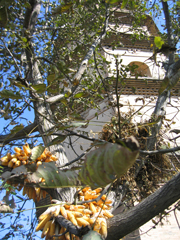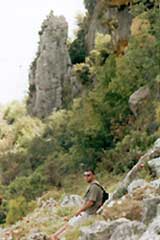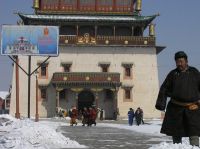Independent highlights ARC's work in Easter edition
April 11 2007:
 |
 |
 |
The earliest Christian site in China - Daqin, in Shaanxi, is in an area threatened by pollution and rapid development. |
The Independent on Sunday newspaper in the UK this weekend featured ARC’s work with sacred sites in its special Easter Sunday edition.
The piece, entitled “Save our holy lands”, and written by Geoffrey Lean, highlighted how thousands of sacred places around the globe are to be linked together in a network supported by the United Nations with the help of ARC, to try to preserve the world's fast-disappearing wild species, as well as save environments beloved by humans.
The sites range from Jerusalem's Garden Tomb - where more than 3,000 people gathered at the weekend to celebrate Easter - to "skull caves" in Kenya, from a Mongolian mountain revered by some Buddhists as a living God to a "spiritual park" in the Peruvian Andes.
The piece emphasised how religions are among the planet's biggest landowners, and how their especially sacred sites are usually havens of wildlife because they have been safeguarded by spiritual traditions or taboos.
It quoted from the new Atlas of Religion – published by Earthscan this month, and written by ARC’s Joanne Robinson and Martin Palmer - which states how the religions, between them, "own over 7 per cent of the habitable land of the planet."
 |
 |
 |
The Lebanese sacred Qadisha valley, a place of rare plants, animals - as well as rare peace. |
In an interview with The Independent, Palmer cited the Garden Tomb as one model of what can be done, saying that the site owes its origin to a visit to Jerusalem by General Gordon, later killed in Khartoum. Unlike most scholars, the Victorian general refused to believe that the Church of the Holy Sepulchre stands on the site where Christ was buried, on the grounds that it was in Jerusalem, instead of outside - doubtless not realising that the city would have grown in the intervening 18 centuries.
Instead Gordon found a first-century tomb near a rocky crag, which looked to him as if it could be "the place of the skull" identified in the New Testament as the site of the crucifixion, and decided that it must the right place. Believers planted the land around it with flowers and trees mentioned in the Bible and it is now a valued wildlife site.
Palmer calls the world's sacred sites "the largest as yet unprotected network of pristine areas on the planet". He believes that by giving than an official designation he will make it much harder for them to be damaged.
The article showed how the campaign is starting pilot schemes in Lebanon, Mexico and elsewhere, and hopes to have official designations in place within five years.
 |
 |
 |
Mongolia is learning to remember its sacred places, and protect them. |
LinksLink here for the full Independent on Sunday story.
Link here for a story the Independent on Sunday ran in 2006 on a sacred sites theme, including ARC's work.
Link here for more information about ARC's sacred sites projects.
Link here for our projects on Sacred Land.
|

